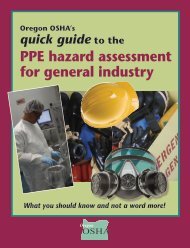Technical Manual - Section 3 (Safety Hazards)
Technical Manual - Section 3 (Safety Hazards)
Technical Manual - Section 3 (Safety Hazards)
You also want an ePaper? Increase the reach of your titles
YUMPU automatically turns print PDFs into web optimized ePapers that Google loves.
SECTION III: CHAPTER 2<br />
PETROLEUM REFINING PROCESSES<br />
A. INTRODUCTION<br />
The petroleum industry began with the successful drilling of<br />
the first commercial oil well in 1859, and the opening of the<br />
first refinery two years later to process the crude into<br />
kerosene. The evolution of petroleum refining from simple<br />
distillation to today's sophisticated processes has created a<br />
need for health and safety management procedures and safe<br />
work practices. To those unfamiliar with the industry,<br />
petroleum refineries may appear to be complex and confusing<br />
places. Refining is the processing of one complex mixture of<br />
hydrocarbons into a number of other complex mixtures of<br />
hydrocarbons. The safe and orderly processing of crude oil<br />
into flammable gases and liquids at high temperatures and<br />
pressures using vessels, equipment, and piping subjected to<br />
stress and corrosion requires considerable knowledge,<br />
control, and expertise.<br />
<strong>Safety</strong> and health professionals, working with process,<br />
chemical, instrumentation, and metallurgical engineers, assure<br />
that potential physical, mechanical, chemical, and health<br />
hazards are recognized and provisions are made for safe<br />
operating practices and appropriate protective measures.<br />
These<br />
A. Introduction. . . . . . . . . . . . . . . . . . . . . . . . III:2-1<br />
B. Overview of the Petroleum Industry. . . . . III:2-2<br />
C. Petroleum Refining Operations . . . . . . . III:2-11<br />
D. Description of Petroleum Refining<br />
Processes and Related Health and<br />
<strong>Safety</strong> Considerations. . . . . . . . . . . . . . III:2-15<br />
E. Other Refinery Operations. . . . . . . . . . . III:2-49<br />
F. Bibliography. . . . . . . . . . . . . . . . . . . . . . III:2-58<br />
Appendix III:2-1. Glossary. . . . . . . . . . . . . .III:2-59<br />
measures may include hard hats, safety glasses and goggles,<br />
safety shoes, hearing protection, respiratory protection, and<br />
protective clothing such as fire resistant clothing where<br />
required. In addition, procedures should be established to<br />
assure compliance with applicable regulations and standards<br />
such as hazard communications, confined space entry, and<br />
process safety management.<br />
This chapter of the technical manual covers the history of<br />
refinery processing, characteristics of crude oil, hydrocarbon<br />
types and chemistry, and major refinery products and<br />
by-products. It presents information on technology as<br />
normally practiced in present operations. It describes the<br />
more common refinery processes and includes relevant safety<br />
and health information. Additional information covers<br />
refinery utilities and miscellaneous supporting activities<br />
related to hydrocarbon processing. Field personnel will learn<br />
what to expect in various facilities regarding typical materials<br />
and process methods, equipment, potential hazards, and<br />
exposures.<br />
The information presented refers to fire prevention, industrial<br />
hygiene, and safe work practices, and is not intended to<br />
provide comprehensive guidelines for protective measures<br />
and/or compliance with regulatory requirements. As some of<br />
the terminology is industry-specific, a glossary is provided as<br />
an appendix. This chapter does not cover petrochemical<br />
processing.<br />
III:2-1
















